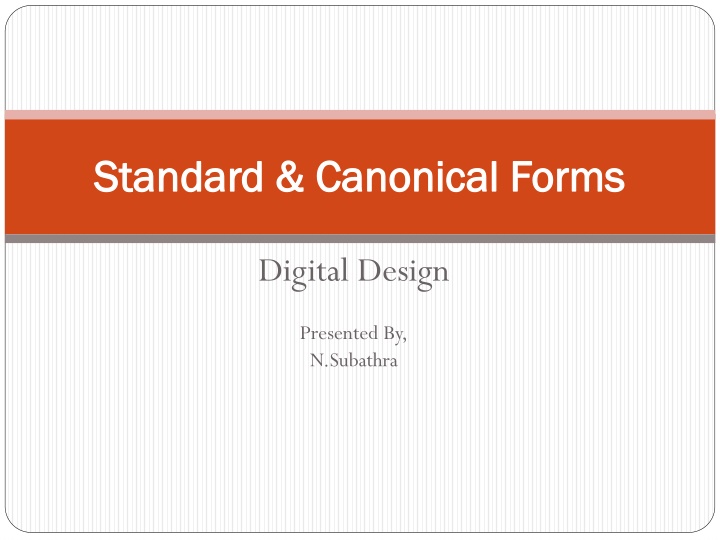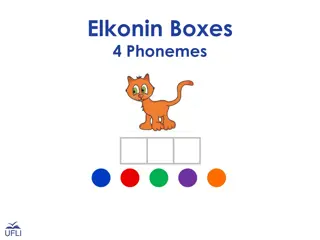
Canonical Forms in Digital Logic Design
Explore the concepts of minterms, maxterms, and canonical forms in digital logic design, presented through informative slides with detailed explanations. Learn about the expressions of functions as sums of minterms and products of maxterms, two-level implementations, and more in COE 202 Digital Logic Design at KFUPM.
Download Presentation

Please find below an Image/Link to download the presentation.
The content on the website is provided AS IS for your information and personal use only. It may not be sold, licensed, or shared on other websites without obtaining consent from the author. If you encounter any issues during the download, it is possible that the publisher has removed the file from their server.
You are allowed to download the files provided on this website for personal or commercial use, subject to the condition that they are used lawfully. All files are the property of their respective owners.
The content on the website is provided AS IS for your information and personal use only. It may not be sold, licensed, or shared on other websites without obtaining consent from the author.
E N D
Presentation Transcript
Standard & Canonical Forms Standard & Canonical Forms Digital Design Presented By, N.Subathra
Outline Minterms Maxterms Expressing Functions as a Sum of Minterms and Product of Maxterms Canonical Forms Standard Forms Two-Level Implementations of Standard Forms Standard & Canonical Forms COE 202 Digital Logic Design KFUPM slide 2
MinTerms Consider a system of 3 input signals (variables) x, y, & z. A term which ANDs all input variables, either in the true or complement form, is called a minterm. Thus, the considered 3-input system has 8 minterms, namely: Each minterm equals 1 at exactly one particular input combination and is equal to 0 at all other combinations Thus, for example, is always equal to 0 except for the input combination xyz = 000, where it is equal to 1. Accordingly, the minterm is referred to as m0. In general, minterms are designated mi,where i corresponds the input combination at which this minterm is equal to 1. Standard & Canonical Forms COE 202 Digital Logic Design KFUPM slide 3
MinTerms For the 3-input system under consideration, the number of possible input combinations is 23, or 8. This means that the system has a total of 8 minterms as follows: Standard & Canonical Forms COE 202 Digital Logic Design KFUPM slide 4
MinTerms In general, for n-input variables, the number of minterms = the total number of possible input combinations = 2n. A minterm = 0 at all input combinations except one where the minterm = 1. Example: What is the number of minterms for a function with 5 input variables? Number of minterms = 25 =32 minterms. Standard & Canonical Forms COE 202 Digital Logic Design KFUPM slide 5
MaxTerms Consider a circuit of 3 input signals (variables) x, y, & z. A term which ORs all input variables, either in the true or complement form, is called a Maxterm. With 3-input variables, the system under consideration has a total of 8 Maxterms, namely: Each Maxterm equals 0 at exactly one of the 8 possible input combinations and is equal to 1 at all other combinations. For example, (x + y + z) equals 1 at all input combinations except for the combination xyz = 000, where it is equal to 0. Accordingly, the Maxterm (x + y + z) is referred to as M0. Standard & Canonical Forms COE 202 Digital Logic Design KFUPM slide 6
MaxTerms In general, Maxterms are designated Mi, where i corresponds to the input combination at which this Maxterm is equal to 0. For the 3-input system, the number of possible input combinations is 23, or 8. This means that the system has a total of 8 Maxterms as follows: Standard & Canonical Forms COE 202 Digital Logic Design KFUPM slide 7
MaxTerms For n-input variables, the number of Maxterms = the total number of possible input combinations = 2n. A Maxterm = 1 at all input combinations except one where the Maxterm = 0. Using De-Morgan s theorem, or truth tables, it can be easily shown that: Standard & Canonical Forms COE 202 Digital Logic Design KFUPM slide 8
Expressing Functions as a Sum of Minterms Consider the function F defined by the shown truth table: Now let s rewrite the table, with few added columns. A column i indicating the input combination Four columns of minterms m2, m4, m5and m7 One last column OR-ing the above minterms (m2+m4+m5+m7) From this table, we can clearly see that F = m2+m4+m5+m7 Standard & Canonical Forms COE 202 Digital Logic Design KFUPM slide 9
Expressing Functions as a Sum of Minterms In general, Any function can be expressed by OR-ing all minterms (mi) corresponding to input combinations (i) at which the function has a value of 1. The resulting expression is commonly referred to as the SUM of minterms and is typically expressed as F = (2, 4, 5, 7), where indicates OR-ing of the indicated minterms. Thus, F = (2, 4, 5, 7) = (m2 + m4 + m5 + m7) Standard & Canonical Forms COE 202 Digital Logic Design KFUPM slide 10
Expressing Functions as a Sum of Minterms Consider the example with F and F`. The truth table of F` shows that F` equals 1 at i = 0, 1, 3 and 6, then, F` = m0+ m1+ m3+ m6, F` = (0, 1, 3, 6), F = (2, 4, 5, 7) The sum of minterms expression of F` contains all minterms that do not appear in the sum of minterms expression of F. Standard & Canonical Forms COE 202 Digital Logic Design KFUPM slide 11
Expressing Functions as a Product of Sums Using De-Morgan theorem on equation: This form is designated as the Product of Maxterms and is expressed using the symbol, which is used to designate product in regular algebra, but is used to designate AND-ing in Boolean algebra. F` = (2, 4, 5, 7) = M2. M4. M5. M7 F` = (0, 1, 3, 6) = (2, 4, 5, 7) Standard & Canonical Forms COE 202 Digital Logic Design KFUPM slide 12
Expressing Functions as Sum of Minterms or Product of Maxterms Any function can be expressed both as a sum of minterms ( mi) and as a product of maxterms ( Mj). The product of maxterms expression ( Mj) of F contains all maxterms Mj ( j i) that do not appear in the sum of minterms expression of F. The sum of minterms expression of F` contains all minterms that do not appear in the sum of minterms expression of F. This is true for all complementary functions. Thus, each of the 2nminterms will appear either in the sum of minterms expression of F or the sum of minterms expression of F` but not both. Standard & Canonical Forms COE 202 Digital Logic Design KFUPM slide 13
Expressing Functions as Sum of Minterms or Product of Maxterms The product of maxterms expression of F` contains all maxterms that do not appear in the product of maxterms expression of F. This is true for all complementary functions. Thus, each of the 2nmaxterms will appear either in the product of maxterms expression of F or the product of maxterms expression of F` but not both. Standard & Canonical Forms COE 202 Digital Logic Design KFUPM slide 14
Expressing Functions as Sum of Minterms or Product of Maxterms Example: Given that F (a, b, c, d) = (0, 1, 2, 4, 5, 7), derive the product of maxterms expression of F and the two standard form expressions of F`. Since the system has 4 input variables (a, b, c & d), the number of minterms and maxterms = 24= 16 F (a, b, c, d) = (0, 1, 2, 4, 5, 7) F = (3, 6, 8, 9, 10, 11, 12, 13, 14, 15) F` = (3, 6, 8, 9, 10, 11, 12, 13, 14, 15). F` = (0, 1, 2, 4, 5, 7) Standard & Canonical Forms COE 202 Digital Logic Design KFUPM slide 15
Finding the Sum of Minterms from a Given Expression Let F(A,B,C)= A B + A C, express F as a sum of minterms F(A,B,C)= A B (C+C ) + A C (B+B ) = ABC + ABC + A BC + A B C = (1, 3, 6, 7) Short Cut Method: A B = 1 1 - This gives us the input combinations 110 and 111 which correspond to m6 and m7 A C = 0 1 This gives us the input combinations 001and 011 which correspond to m1 and m3 Standard & Canonical Forms COE 202 Digital Logic Design KFUPM slide 16
Operations on Functions The AND operation on two functions corresponds to the intersection of the two sets of minterms of the functions The OR operation on two functions corresponds to the union of the two sets of minterms of the functions Example Let F(A,B,C)= m(1, 3, 6, 7) and G(A,B,C)= m(0,1, 2, 4,6, 7) F . G = m(1, 6, 7) F + G = m(0,1, 2, 3, 4,6, 7) F . G = ? F = m(0, 2, 4, 5) F . G = m(0, 2, 4) Standard & Canonical Forms COE 202 Digital Logic Design KFUPM slide 17
Canonical Forms The sum of minterms and the product of maxterms forms of Boolean expressions are known as canonical forms. Canonical form means that all equivalent functions will have a unique and equal representation. Two functions are equal if and only if they have the same sum of minterms and the same product of maxterms. Example: Are the functions F1 = a' b' + a c + b c ' and F2 = a' c' + a b + b' c Equal? F1 = a' b' + a c + b c ' = m(0, 1, 2 , 5, 6, 7) F2 = a' c' + a b + b' c = m(0, 1, 2 , 5, 6, 7) They are equal as they have the same set of minterms. Standard & Canonical Forms COE 202 Digital Logic Design KFUPM slide 18
Standard Forms A product term is a term with ANDed literals. Thus, AB, A B, A CD are all product terms. A minterm is a special case of a product term where all input variables appear in the product term either in the true or complement form. A sum term is a term with ORed literals. Thus, (A+B), (A +B), (A +C+D) are all sum terms. A maxterm is a special case of a sum term where all input variables, either in the true or complement form, are ORed together. Standard & Canonical Forms COE 202 Digital Logic Design KFUPM slide 19
Standard Forms Boolean functions can generally be expressed in the form of a Sum of Products (SOP) or in the form of a Product of Sums (POS). The sum of minterms form is a special case of the SOP form where all product terms are minterms. The product of maxterms form is a special case of the POS form where all sum terms are maxterms. The SOP and POS forms are Standard forms for representing Boolean functions. Standard & Canonical Forms COE 202 Digital Logic Design KFUPM slide 20
Two-Level Implementations of Standard Forms Sum of Products Expressions (SOP): Any SOP expression can be implemented in 2-levels of gates. The first level consists of a number of AND gates which equals the number of product terms in the expression. Each AND gate implements one of the product terms in the expression. The second level consists of a SINGLE OR gate whose number of inputs equals the number of product terms in the expression. Standard & Canonical Forms COE 202 Digital Logic Design KFUPM slide 21
Two-Level Implementations of Standard Forms Example: Implement the following SOP function F = XZ + Y`Z + X`YZ Standard & Canonical Forms COE 202 Digital Logic Design KFUPM slide 22
Two-Level Implementations of Standard Forms Product of Sums Expression (POS): Any POS expression can be implemented in 2-levels of gates. The first level consists of a number of OR gates which equals the number of sum terms in the expression. Each gate implements one of the sum terms in the expression. The second level consists of a SINGLE AND gate whose number of inputs equals the number of sum terms. Standard & Canonical Forms COE 202 Digital Logic Design KFUPM slide 23
Two-Level Implementations of Standard Forms Example: Implement the following POS function F = (X+Z )(Y`+Z)(X`+Y+Z ) Standard & Canonical Forms COE 202 Digital Logic Design KFUPM slide 24






















